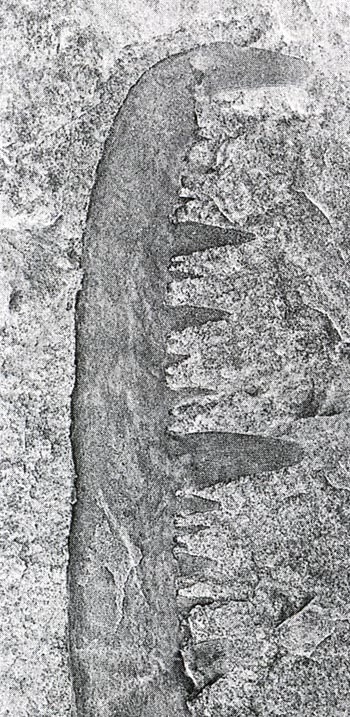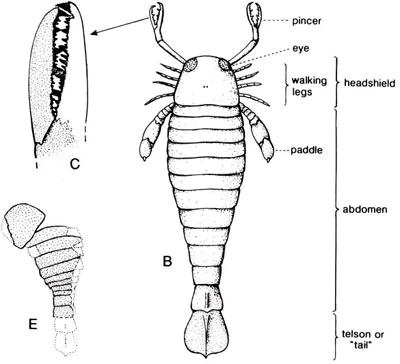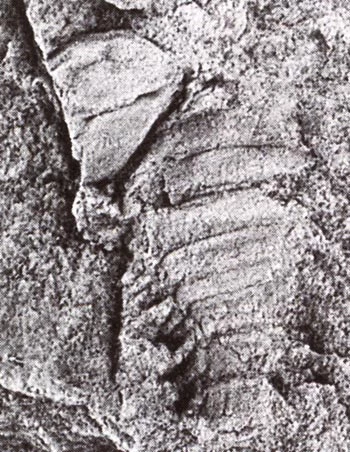Terror of the Silurian Seas
The eurypterid from Radnor Forest (x1.5)
The reconstruction of the eurypterid from Radnor Forest
The small specimen from the Woolhope district (x3.5). Note that the headshield is displaced to the left.
Numerous specimens are brought in to the Department of Geology every year by the general public for identification. In most cases, these are common fossils or minerals, but from time to time something more unusual turns up, as happened in December 1989 when Mr Stephen Jenkins of Brecon produced a strange-looking fossil that he had found on the side of a forestry road in Radnor Forest.
A large scorpion-like animal
Although it superficially resembled a fish jaw with a series of pointed teeth of different sizes, careful examination led us to dismiss this possibility, and we eventually succeeded in tracking down what it was - half a pincer of an extinct, aquatic, scorpion-like animal called a eurypterid. A remarkable aspect of this specimen is its size - 64mm (2.5 inches) long, which indicates that it belonged to an individual that must have been around 70cm (27 inches) long. The rocks in which it was found in Radnor belong to the Ludlow Series of the Silurian System - about 420 million years old.
Despite their superficial resemblance to scorpions, eurypterids are not closely related to them, although they belong to the same general division of the arthropods - invertebrate animals with jointed legs that include spiders, crabs, lobsters and insects.
Flourishing from about 480 million years ago until their extinction 250 million years ago, most eurypterids are found in rocks that were deposited in fresh or brackish (mix of salt and fresh) water; only a few, including the Radnor Forest specimen, are from rocks of truly marine origin. It is possible, however that the specimen was washed out to sea from shallower waters that lay to the east of Radnor Forest.
Gigantic carnivores of the sea
The pincer belongs to a eurypterid genus named Pterygotus, which was an active swimmer. We can only speculate what might have been its prey, but it probably included primitive fish. The largest known specimens from other parts of the world are almost 3m (10 feet) long, and are the largest arthropods known. The specimen in Amgueddfa Cymru is not quite of those gigantic dimensions! The majority of eurypterids did not reach such a large size.
By coincidence, a short while after the pincer was brought into the Museum, another eurypterid was presented, this time with the 'body' section preserved. It was collected from slightly younger (400 million years old) Silurian rocks exposed near Woolhope (Herefordshire) by Dr. Paul Selden, formerly of Manchester University, and measuring only 0.9cm (0.3 inches) long, it is at the other end of the size scale. This is probably an immature specimen, and the full-grown animal might have been in the region of 10cm (4 inches) long.
Both specimens are now in the Museum collections, thanks to the generosity of their finders. Over the years the general public and academic colleagues have constantly enriched our collections, and donations of this kind remain an important source of material. You never can tell what might be brought in tomorrow...


